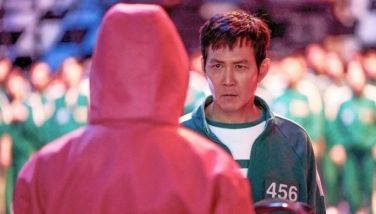"Amigo" on tour
CEBU, Philippines - Obviously there’s something wrong with the sound (other parts inaudible, some louder than usual and necessary) that Fil-Am wartime drama “Amigo” executive producer Maggie Renzi whispered to me during the February 10 (4 p.m.) advance screening at the SM City Cebu how frustrating it was to listen to the muffled exchanges, to watch those “poor prints”, and that she has to “check lab works first.”
“We’re still trying to figure out if this has to do with the stereo placement during the mix at Roadrunner or the optical printing. It sounds good on the DVD, so I think it’s a Dolby/printing problem. Very frustrating,” said the Oscar-nominated American director and screenwriter John Sayles, husband of Maggie Renzi.
Anyway, the movie is about the failure of the Resistance Movement during the Filipino-American War in the 1900s of which very little has been written. Yes, it’s tragic. Since this is a historical piece, we can’t do anything about it but watch from frame to frame how we Filipinos demonstrated our ardent desire to be self-governed, eventually losing the battle because we can’t even identify our real enemies apart from our real allies.
I was most touched by the concluding part wherein the son of San Isidro cabeza del barrio Rafael Dacanay cut the wire supposedly sending cablegram, not realizing that the Americans were waiting for a reversal in the execution order against his father. I pointed out to Sayles that even Rafael’s son became his father’s enemy at that point. Rafael could have had a second lease at life, but it was his son who decided to end it, unwittingly.
“The son cutting the wire represents for me the terrible point when a failed revolution begins to eat itself doing more harm than good for the people it is trying to liberate,” Sayles stressed.
“This is so hard to judge when you’re in the field and on the run. When do you admit you can’t win and hand in your weapons (for 30 Mexican pesos)? Who is in charge of saying that the man who hands his weapons in one day is a traitor and a coward, but if he does it two days later he is just a patriot being sensible?”
“War is hard enough to judge in hindsight how difficult to make those decision when the bullets are still flying. War is and will always be murder that we dignify with our rational stories,” he emphasized.
The cockfight scene, which utilized a parallel montage, was also cleverly written to highlight how “fighting cocks are so much better than human beings having the ability to display higher level of stamina and better performance in battle”. I see this as a mock on us Filipinos who do not really put a good fight even when immersed in some kind of ideology. It is a perspective that in the past battles, we succumb immediately to indoctrination, to misguided information (as was lost in translation), and are open to befriending our enemies even to the point of feeding them literally.
According to Sayles, that scene (with Spanky Manikan of “Himala” fame) talking about fighting birds is not so simple like human beings. “Yes, the cocks will fight to the death almost every time. But who wants to live with the tiny, easily indoctrinated brain of a chicken?”
“Filipinos through the years have adopted various strategies of resistance/acceptance to their conquerors, like anybody dealing with powers they can’t overcome. I think survival is the human being’s strongest instinct and the Filipino people have survived an awful lot. And as the character of Padre Hidalgo says, you have to be aware of what is ‘behind the smile’ colonized people everywhere get the reputation of being crafty and devious. However, these are mostly survival tactics in a difficult situation,” he explained.
I also noted of Chinese people I suppose were settlers in Luzon who were once traders. “So were they subjects of forced labor too?” I asked Sayles.
“The Cantonese-speaking guys in the movie talk about making enough money to go home to China and buy some land. Around 1900, these would be men who came over to Manila on two-year labor contracts and did coolie labor for whoever paid the best,” he narrated.
“When the revolution against the Spanish began they were often hired by the Spanish army to be porters, cooks, to do laundry, etc. (increasing the already tense relations between Filipinos and Chinese). When the Americans ‘took over’ the war, they also took over hiring the coolies to work for them. But since the Chinese were not armed, they were very vulnerable to guerilla attack. Killing the American coolies was seen as little more violent than trying to steal their horses or supplies,” this we further learned from Sayles.
Moreover, I shared appreciation for a shot on a puddle where the young Filipina named Azalea got reflected on, the technique, and its essential place in the roll.
“Our director of photography Lee Meilly-Briones used two RED cameras—digital—in the filming. These are very good now but you have to be careful where you point them when the sun is bright or the sky will ‘burn out’,” Sayles said.
“The shot of Azalea in the puddle is an upbeat way of showing that the long monsoon season is over; that we have been seeing rain, rain, rain and now here is standing water with enough sun for us to see the girl’s reflection so of course it makes her smile. Shooting digitally is finally much cheaper than shooting film, and pretty much all you’ll see from independent filmmakers in the future.”
Another very interesting shot is the set of women’s feet hurrying past the camera under the drenching rain as if you feel the soothing raindrops on your face, as well as the sloshes of mud splattering from the women’s footwear.
“That shot was basically just a low-angle setup to put the audience down in the mud as the rain hits it, but it also is intended to give more drama to the appearance (from above and behind the camera) of the women running out to bring the now crazy mother (who lost her little girl in one of the night attacks) out of the rain,” he pointed out.
My other concern is about the twang of American soldier-actors that make their lines hard to understand. It could have been the reason why some of the students were just talking shop with their seatmates and would only focus back on the story if it’s dealing with the “romantic angle” (between Azalea and young soldier named Gil). In fact, Maggie Renzi again whispered: “Are Filipino audience really this talkative?”
Sayles replied: “The soldiers are supposed to be from various parts of the US—the lieutenant from Minnesota, the sergeant from Oklahoma, young Gil who gets paralyzed is from Texas. But most of them are not very educated and tend to slur their words or speak in an accent.”
Commercial release of “Amigo” is scheduled on July 6 here in the Philippines, just after July 4 which is Fil-Am Friendship Day and will open in US theaters on August. Although produced, written, directed and edited by an American, the film is entirely shot in Maribojoc, Bohol (Barangay Tirol specifically), and that the staff and crew is 100-percent Filipino. It features Oscar-award winning actor Chris Cooper, as well as highly regarded Filipino thespians Joel Torre, Ronnie Lazaro, Rio Locsin, Pen Medina, Bembol Roco, Irma Adlawan, John Arcilla, Spanky Manikan and Bodjie Pascua, among others.
Sayles and Renzi said that the “Lakbay Amigo: The Philippine Sneak Previews” is their way of fueling word-of-mouth especially among educators and students. The movie has been supported by regional partners and universities in Bohol (Feb.9), Cebu (Feb. 10-11), Davao (Feb. 12-13), San Beda College Alabang/Cultural Center of the Philippines (Feb. 15), De La Salle University (Feb. 16), Pampanga (Feb. 17), Baguio City (Feb. 19-20), Bacolod (Feb. 21), and UP Diliman (Feb. 22).
The film is based on Sayles’ ‘monumental’ new book “A Moment in the Sun” due for release in April. It tackles about the white coup in Wilmington, North Carolina, to the bloody dawn of U.S. interventionism in Cuba and the Philippines.
“Built on the voices of a breathtaking range of exiles in search of opportunity, the full book is a tremendous chronicle of a pivotal time. This is a story as big as its subject: history rediscovered through the lives of the people who made it happen,” a portion read.
Sayles’ previous novels include Pride of the Bimbos, Los Gusanos, and the National Book Award–nominated Union Dues. He has directed 17 feature films, including Matewan, Eight Men Out, and Lone Star, and received a John Cassavetes Award, a John Steinbeck Award, and two Academy Award nominations.
Among the local cinema talents who joined him for the Cebu screening are Joel Torre who played Rafael Dacanay and John Arcilla as the villain Saturnino/Nenong who has always believed in Spanish rule and the “teachings” of the church. (FREEMAN)
- Latest
- Trending

























